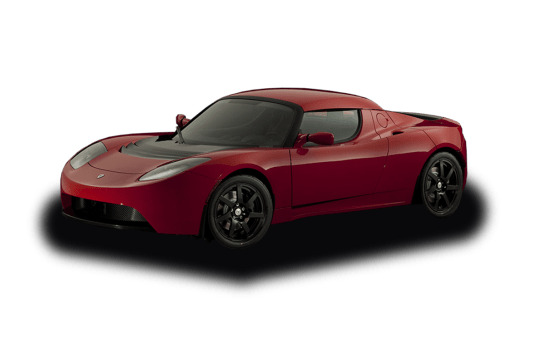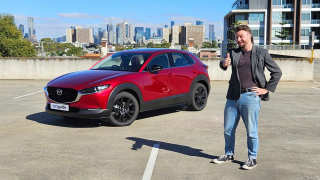
Tesla Roadster 2.5 Sport 2011 review
- Tesla Roadster
- Tesla Roadster Reviews
- Tesla Reviews
- Convertible
- Coupe
- Tesla
- Prestige & Luxury Cars
- Green Cars
"FUEL, sir?" Not unless you have a plug, a 30m lead and eight hours to spare. Force of habit has taken me into a petrol station to pause, stretch the legs and put the roof up. It's a blistering Sydney day and top-down this Tesla Roadster is too hot for comfort.
But of course I could have pulled in anywhere, because this Roadster, one of just a handful in Australia, is an electric sportscar. It no more drinks petrol when it's parched than you or me. If its batteries needed replenishing, then there would be no point stopping here.
Besides, the Roadster is charged to the brim. Awaiting my arrival, it was connected to a special box on the wall of Tesla's nascent Sydney HQ by a cable as thick as a baby's arm. Most owners are expected to invest in one of these fast chargers, which lower the time on life-support to 3 1/2 hours. They're not cheap at $4500, but then you're not buying a hatchback.

Explore the 2011 Tesla Roadster range
Plugged into the mains with a three-pin, you'll need to leave it overnight to juice it up for its 360km range. The rewards for your patience are running costs well below anything with an engine. At $10 a fill, the Roadster does the equivalent of about 2 litres per 100km. No sportscar - or hybrid, for that matter - can come close.
Nothing comes out of the tailpipe either, because there isn't one. Previously, my exposure to electric vehicles has been limited to a few kilometres in city runabouts, a couple of laps in experimental prototypes, and fun fair dodgems.
This is the first time I've been free to explore the limits of one without a minder looking over my shoulder. And its limits are one of the first things on my mind. The car's theoretical 360km range constantly changes in line with my right foot. Hit the throttle hard for a minute or two and the range display drops precipitously. If I switch it into Sport mode, it drops even more.
My intended route covers about 200km, so it should be doable. But getting it wrong would be an embarrassing, not to say time-wasting, disaster. I realise I'm already suffering from range concern and I fear it's a precursor to full-blown range anxiety.
Carmakers vary in their assessment of this ailment. Depending on the degree of their commitment to the battery car, it's either a debilitating disease that can leave you totally reliant on public transport, or it's a completely irrational fear and you just need to get a grip.
Reason prevails and I press on. Putting the roof up - a manual procedure on a par with pitching a swag - has made the heat more bearable and served as a reminder of how the Roadster started life.
DESIGN
It's based on a Lotus Elise, the tiny British sportscar, but with the aluminium chassis widened a bit and all the panels, in carbon fibre, bespoke to the Tesla. The Californians then fit 6831 lithium-ion batteries, an electric motor, a single-speed gearbox and a box of electronic gubbins behind the cabin. Tesla says just 7 per cent of the final car is actually a Lotus Elise.
From the driver's seat it feels like more, because the cabin is extremely similar. The main difference is a small centre console where the gearstick would normally be, which houses a touchscreen to access the Roadster's brain.
The thick sills that make getting in and out of an Elise so difficult are the same, as are the dash and the steering wheel. There's the same dreadful Alpine audio and satnav system used by Lotus, and the same airconditioning system with two settings: loud and louder.
TECHNOLOGY
Perhaps it's 7 per cent by weight, because the batteries and other stuff behind me weigh 450kg. All told, two-thirds of the Roadster's 1450kg sit over the rear axle. And that's before you've squeezed luggage into the 170-litre boot, which sits right in the tail.
Uneven weight distribution is obviously not ideal and initially I'm acutely aware of it. But it's not unique in the car world. Floor the throttle and the Tesla's nose bobs up, a bit like a Porsche 911's. Also like a 911, the rear tyres have no problem getting traction down and have a mountain of grip.
DRIVING
Once you get used to it, the car feels tied down and through corners it stays remarkably flat. The suspension has to be firm to get that result, but that's what you expect anyway in a sportscar. Usually, the price would be an unbearable ride quality, but it isn't. There's less jolting than in an Elise.
Which isn't to say it's a serene place to be. Wind and road noise thunder through an Elise, with its lack of insulation and roll-your-own roof, and it's no different here. There's less engine noise to smoother the racket - and pedestrians might be oblivious - but inside the motor is louder than expected.
When we're all driving electric cars because V8s have been banned, the Tesla might be remembered as one of the songbirds of the flock. While we can still enjoy the glorious tunes that petrol can make, though, it's never going to make the charts. It sounds like a tram that's entered Formula One.
The question of how much sound plays in the magic of a sportscar comes to the fore with the Tesla. Because it doesn't lack handling and it certainly doesn't lack acceleration. The first time I experienced an electric car at maximum volts will stay with me for some time.
The Sport version, driven here, goes like a cat that's stuck its claws in the mains. It will hit 100km/h in under 4 seconds. That's a supercar, whatever it's got in the tank. Even if it doesn't have tank. Uphill, when the instantaneous torque comes into its own, it's fantastic. Downhill you can exploit the dramatic engine braking.
With only a single gear, revs and speed move in tandem and one dial serves to measure both. The Roadster maxes out at 14,000 revs, which is F1-like, and that equates to just over 200km/h. Which isn't enough for F1, but just about enough for Sydney.
The range proves sufficient as well, although there's not a lot to spare when I get back. The car's electronics step in to curb lead-foot tendencies as the range dwindles, or to prevent the batteries overheating.
VERDICT
The Roadster is an extremely unusual sportscar and the company thinks as many as 40 Australians a year will be curious enough to buy one. It has many of the drawbacks of the donor Lotus but, for the moment at least, offers something unique in the way it delivers supercar performance. Something with eco-credentials.
And I find consolation in the paradox of this. Nobody, after all, needs a sportscar. It would be greener not to buy one at all. Tesla sees itself as allied to the environmental movement. I prefer to think of it as working undercover for the other side.






